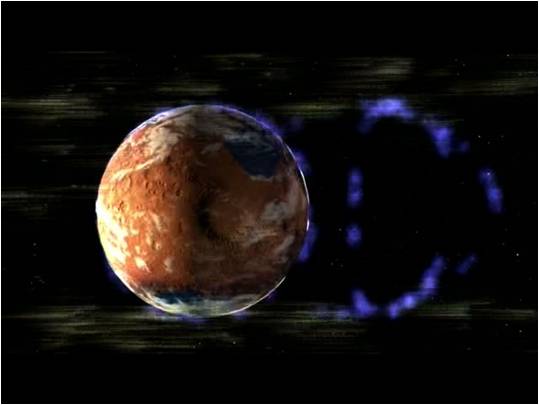

Why do planets like Mars have a different atmosphere than Earth? Credit: NASA
[/caption]Mars is a strange planet.
There is evidence that the Red Planet once played host to a thick atmosphere and vast oceans. However, at some point in its evolution, the planet seemed to leak the majority of its atmospheric gases into space, and its oceans evaporated (or froze and then sublimated, depending on how fast atmospheric pressure was lost). There are several theories as to how the Martian atmosphere wasted away to 1% of that of the Earth’s, including the slow erosion by solar wind particles and a sudden, catastrophic asteroid impact, blasting the atmosphere into space.
Planetary scientists have known for a long time that the Martian magnetic field is very weak and therefore has little protective strength from the continuous solar wind. Through analysis of data from the retired NASA Mars Global Surveyor (MGS) satellite, a new insight has been gained.
Far from being benign however, this weak crustal magnetic field may actually be having an adverse effect on the atmosphere, capturing atmospheric particles in magnetic “bubbles” (a.k.a. plasmoids) over a thousand kilometres wide, before being blown en-mass into space…
The erosion of the Martian atmosphere by the solar wind has been long suspected as the primary mechanism behind the loss of Martian air. Although Mars air is significantly different to our own (the Martian atmosphere is primarily CO2-based, whereas the terrestrial atmosphere has a breathable nitrogen-oxygen mix), it was once thought to be much more dense than it is today.
So where did the atmosphere go? As the Martian magnetosphere is pretty insignificant (scientist believe that the global magnetic field may have been a lot stronger in the past and possibly damaged by an asteroid impact), there is little to deflect energetic solar wind ions from interacting with the atmosphere below. On Earth, we have a very strong magnetosphere acting as an invisible forcefield, preventing charged particles from entering our atmosphere. Mars does not have this luxury.
During the Mars Global Surveyor mission, launched in 1996 (ending in 2006), the satellite detected a very patchy magnetic field originating from the Martian crust, predominately in the southern hemisphere. The natural thought would be that, although weak, this patchy field might provide some limited protection for the atmosphere. According to new research using old MGS data, this is probably not the case; the crustal magnetic field may be contributing to, possibly accelerating, the air loss.
“The umbrellas are where coherent chunks of air are torn away,” said David Brain of UC Berkeley, who presented his MGS research at the 2008 Huntsville Plasma Workshop on October 27th.
Although this might sound dramatic, there is a real possibility that this process has been observed on Mars for the first time. The magnetic umbrellas reach through the atmosphere and feel dynamic pressure from the solar wind. What happens next is a well known mechanism in the field of magnetohydrodynamics (MHD): reconnection.
As the crustal umbrellas make contact with the interplanetary magnetic field (IMF) carried by the solar wind, there is a chance reconnection may occur. According to David Brain, the MGS passed through such a reconnection region during one of its orbits. “The joined fields wrapped themselves around a packet of gas at the top of the Martian atmosphere, forming a magnetic capsule a thousand kilometers wide with ionized air trapped inside,” he said. “Solar wind pressure caused the capsule to ‘pinch off’ and it blew away, taking its cargo of air with it.”
Since this first result, Brain has found a further dozen magnetic “bubbles” carrying chunks of the Martian ionosphere with them. These bubbles are known as “plasmoids” as they contain charged particles, or plasma.
Brain is keen to point out that these results are far from conclusive. For example, the MGS was only equipped to detect one charged particle, the electron; ions have different characteristics and may therefore be affected differently. Also, the satellite took measurements at a constant altitude at the same local time of day. More data during different times and different altitudes are required.
One such NASA mission that might be able to assist in the plasmoid hunt is the Mars Atmosphere and Volatile Evolution satellite (MAVEN), scheduled for launch in 2013. MAVEN will analyse the Martian atmosphere to specifically study erosion by the solar wind, detecting electrons and ions; measuring not only the magnetic, but the electric field too. MAVEN’s elliptical orbit will also allow the probe to investigate various altitudes at different times.
So we await MAVEN to prove or disprove Brain’s plasmoid theory. Either way, this is some tantalizing evidence pointing to a rather unexpected mechanism that could be, quite literally, ripping Mars’ atmosphere into space…
Source: NASA
Could a new, fifth force of nature provide some answers to our biggest questions about…
In 2015, the United Nations adopted the 2030 Agenda for Sustainable Development—the Sustainable Development Goals…
Astronomers have been battling threats to their clear skies on all fronts lately. One of…
If you were Captain of the first USS Enterprise, where would you go!? Humanity is…
Now is the best time to observe Mars in 2025. Mars from 2014. Credit: Paul…
Scheduled for launch in 2027, the Nancy Grace Roman Telescope is slowly being readied for…